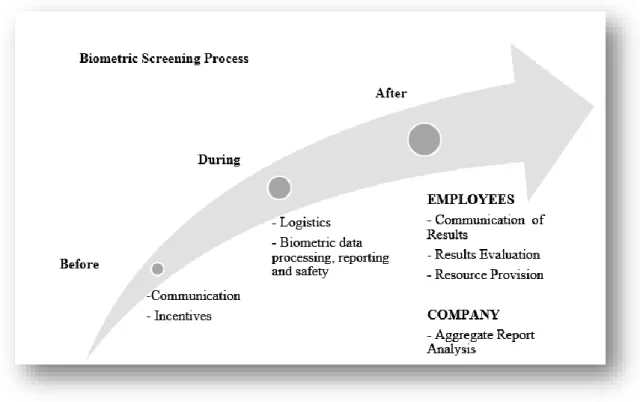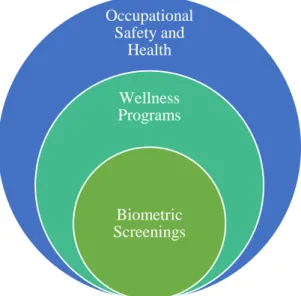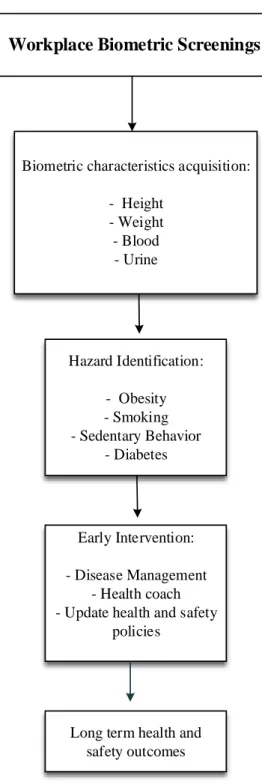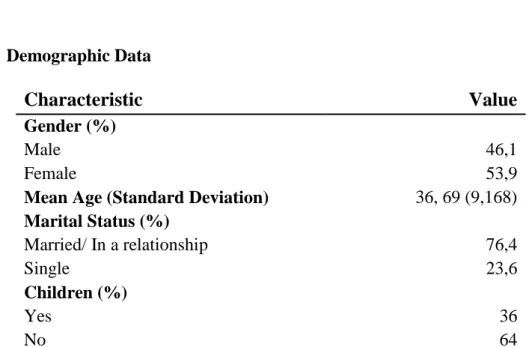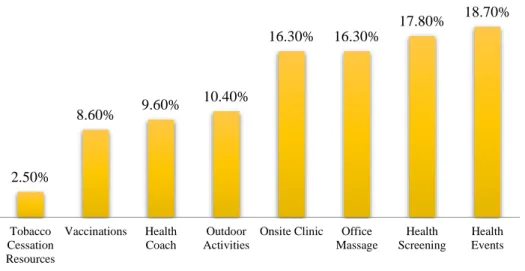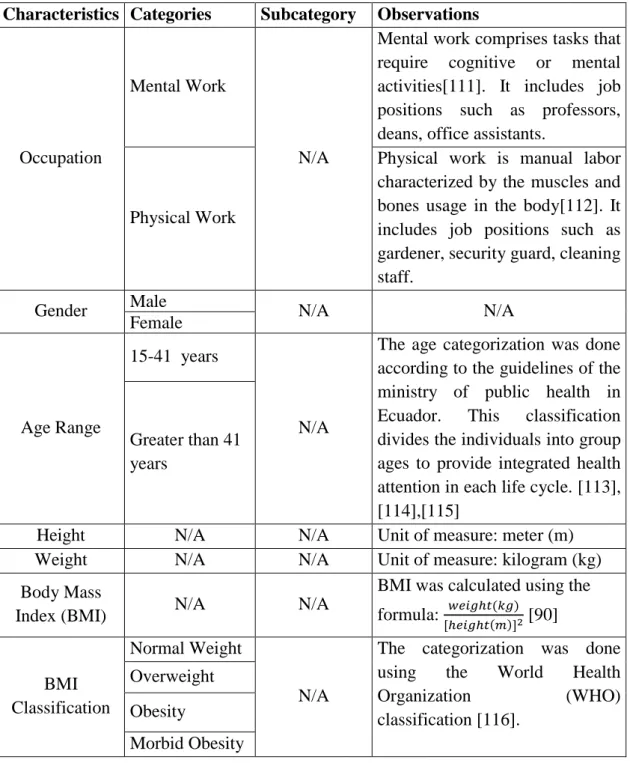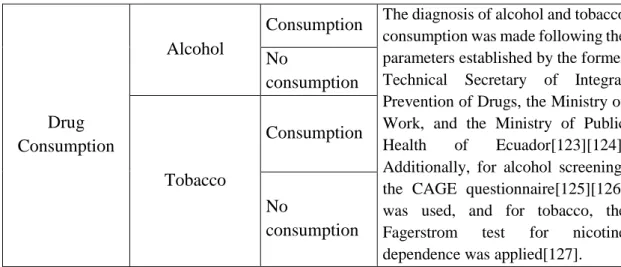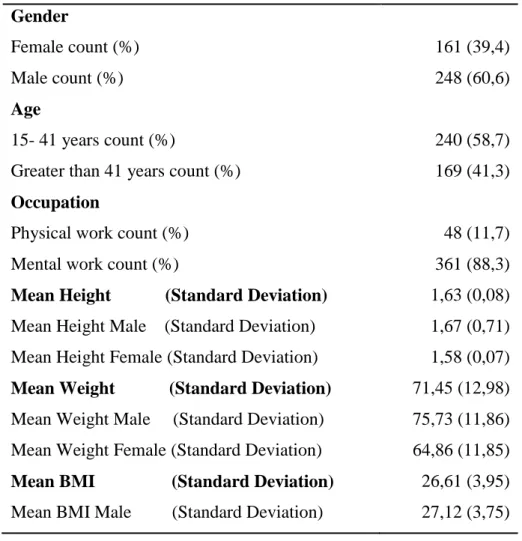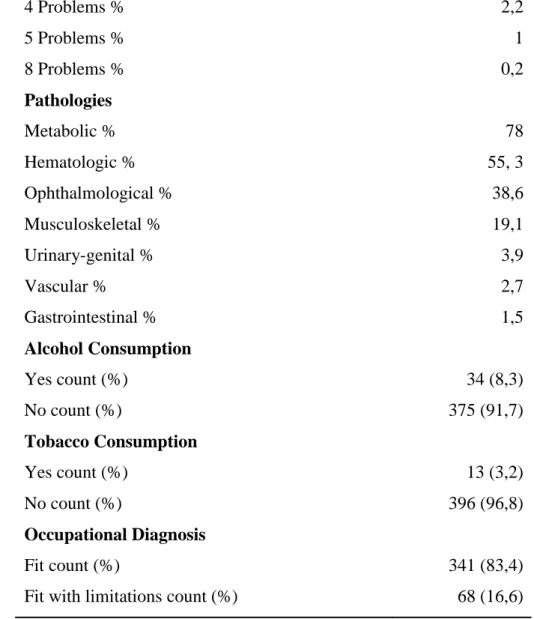DOCTORAL (PhD) THESIS
DOCTORAL SCHOOL ON SAFETY AND SECURITY SCIENCES
2021 LOURDES CECILIA RUIZ SALVADOR
Biometric Screenings:
Insights and their
impact on Occupational Safety and Health
Supervisor: Prof. Dr. Kovács Tibor
2
Examination Committee:
Chair of the Examination Committee:
László Pokorádi CSc, professor – Óbuda University Members:
András Kerti PhD, associate professor – University of Public Service Richárd Pető PhD, senior lecturer – Óbuda University
Public Defence Committee Members:
Chair of the Public Defence Committee:
Lívia Cvetityánin DSc, professor- Óbuda University Secretary:
Arnold Őszi PhD, senior lecturer- Óbuda University Members:
Szabolcs Jobbágy PhD, senior lecturer – University of Public Service András Kerti PhD, associate professor – University of Public Service
Mónika Diószegi PhD, associate professor – Óbuda University
Reviewers:
Gábor Kiss PhD, associate professor – Óbuda University Tibor Farkas PhD, associate professor- University of Public Service
Date of Public Defence
………..
3
DECLARATION
I, Lourdes Cecilia Ruiz Salvador, student of Obuda University, at Banki Donat Faculty and the Doctoral School on Safety and Security Sciences. Hereby declare that I entirely wrote this Ph.D. thesis, except where it is denoted in the references.
4 Abstract
Biometric characteristics such as fingerprints, palmprints, iris, or face recognition have been used at organizations to identify an individual, grant access to physical or digital facilities, and control employees' time and attendance. Nowadays, employers recognize the importance of workers' health. Hence, wellness programs are gaining popularity among enterprises. As part of these programs, other biometric traits such as height, weight, blood glucose, blood pressure, or blood cholesterol are acquired at biometric screening events. The primary objective of biometric screenings is to promote healthy habits within the workforce via early prevention and timely disease interventions. This work aims to present a detailed review of what biometric screenings are, their advantages, disadvantages, and stages of the process. Moreover, to go further from the health benefits that are broadly reported and analyze the screenings implications over occupational safety.
For this purpose, a literature review, preliminary research (survey), and a case study (biometric screenings) were carried out. Literature research and analysis conveyed relevant information regarding the application of biometrics in the workplace via biometric screenings. The revision of pertinent scientific documents delivered essential insights regarding the link between the biometric characteristics collected in a screening event and hazard identification that can affect occupational safety.
Concerning the experimental procedure, preliminary research carried out at a Hungarian company displayed the importance of workplace biometric screenings. Nearly 95% of the respondents stated that biometric screenings are important; more than 88% expressed interest in participating in a screening event. More than 70% of the employees believe that it is the responsibility of the company to safeguard their health. Approximately 90
% prefer an employer with health initiatives, and 61% trust an organization concerned about the worker's health.
Additionally, in the case study done at an Ecuadorian university, primary data from 409 employees were collected through biometric screenings and analyzed using descriptive and inferential statistics. Chi-square tests established statistically significant associations between type of occupation and biometric characteristics such as gender, body mass
5
index, blood and urine sample laboratory results, and age. Logistic regression determined two significant factors that contribute to occupational diagnosis (gender and physical exam results). The study identified clinical problems and pathologies related to mental work. These results were pivotal for identifying specific work hazards such as obesity, musculoskeletal disorders, eye problems, and metabolic diseases. Consequently, biometrics via biometric screenings enhance not only occupational health but also occupational safety by aiding in the prioritization of occupational safety procedures and policies through the identification of occupational hazards found in biometric screening results.
6
TABLE OF CONTENTS
INTRODUCTION ... 9
Problem Description ... 12
Objectives ... 13
Research Methods ... 14
1 THEORETICAL FRAMEWORK: BIOMETRICS, BIOMETRIC SCREENINGS, OCCUPATIONAL SAFETY AND HEALTH ... 15
1.1 Biometrics ... 15
1.1.1 Introduction ... 15
1.1.2 Biometric Uses in the Workplace ... 17
1.2 Biometric Screenings ... 19
1.2.1 Advantages and Disadvantages ... 20
1.2.2 Biometric Screening Measures and Tests ... 21
1.2.3 The Biometric Screening Process ... 23
1.2.3.1 Before the Process ... 23
1.2.3.2 During the Process ... 25
1.2.3.3 After the Process ... 26
1.3 Occupational Safety and Health ... 28
1.3.1 Importance ... 28
1.3.2 Safety versus Health ... 29
1.4 Biometric Screenings and the implication in Occupational safety and health . 30 1.4.1 Industrial Safety Concepts ... 31
1.4.2 Biometric Screenings and Safety ... 32
1.4.3 Biometric Screenings as an Incentive tool ... 33
1.4.4 Biometric Screenings and Performance Influencing Factors ... 34
1.4.5 Biometric Screenings and Hazard Detection ... 34
7
1.4.6 Biometric Screenings: Overlapping concepts between Health and Safety at
work….. ... 37
Hypotheses ... 39
2 EXPERIMENTAL PROCEDURE ... 40
2.1 Preliminary Research ... 41
2.1.1 Antecedents ... 41
2.1.2 Objective and Rationale ... 41
2.1.3 Methodology ... 42
2.1.4 Results ... 42
2.2 Case Study: Biometric screenings results analysis ... 46
2.2.1 Antecedents ... 46
2.2.2 Objective ... 47
2.2.3 Methodology ... 47
2.2.4 Results ... 51
2.2.4.1 Descriptive Statistics ... 51
2.2.4.2 Inferential Statistics ... 62
DISCUSSION ... 72
Preliminary Research ... 72
Case Study Biometric Screenings: Data analysis ... 73
Statistical Analyses ... 74
Hypotheses Discussion ... 76
CONCLUSIONS ... 86
IMPORTANCE OF THE STUDY ... 89
NEW SCIENTIFIC CONTRIBUTIONS... 91
FURTHER RESEARCH, RECOMMENDATIONS, LIMITATIONS ... 93
REFERENCES ... 94
8
LIST OF TABLES ... 105
LIST OF FIGURES ... 106
APPENDICES ... 107
Appendix I: Preliminary Research Survey ... 107
Appendix II: Results Inferential Statistics SPSS ... 111
ACKNOWLEDGMENTS ... 123
9
INTRODUCTION
Fingerprints, iris, palm print, and face recognition are biometric characteristics commonly used in the workplace for granting physical or virtual access to the facilities and controlling employees' time and attendance. The acquisition of biometric identifiers that characterize employees' health conditions is becoming prevalent in the workplace.
Nowadays, companies collect different biometric traits to enhance safety and health at work via biometric screening events, which are part of workplace wellness programs.
Corporate wellness programs are gaining popularity within organizations. In the United States, 54% of employees working full time have access to a workplace health program, while Europe is 23%. The tendency is to upscale the existent programs and the introduction of new ones in multinational companies[1]
Biometric screenings fall under the scope of workplace wellness programs. These screenings are defined as the process of measuring biometric characteristics such as height, weight, blood pressure, cholesterol, blood glucose, physical activity tests, and more acquired at the workplace to assess the health condition of the workforce and monitor the changes throughout time[2]
Research about wellness programs and biometric screenings is predominantly health- based[3]. Regarding the employees, research focuses on health benefits such as early detection of chronic diseases[4][5], motivation into healthy behaviors[6], promotion of healthy lifestyles, and education [7][8]. As for the company, research topics include identification of the organizations benefits such as the return of investment, cut in corporate health plans[5][9][10], ways on how to deploy effective and successful screenings via participation rate[11][12][7] and incentives [13][14][15].
Research about the impact of biometric screenings on safety is not well documented.
Some studies focus on one or two biometric characteristics such as height and weight to identify occupational risk and linkage to work-related diseases [16]–[19]. In other studies, self-assessment tools are used to identify relationships with occupational incidents and health risks[20][21]. However, research concerning the collection of several biometric characteristics at a biometric screening event and the subsequent analysis is incipient.
10
Consequently, a study detailing biometric screenings and how the health examination stimulates workplace safety is relevant. It can bring valuable insights to implementers towards new wellness practices and the importance of these biometric tests. Moreover, the inclusion of a survey and data of an actual biometric screening event complements the theoretical research. Its results can direct the establishment of specific hazards related to the type of occupation and serve as a tool for prioritizing occupational safety and health initiatives, procedures and policies.
The present work comprises of three elements:
1. Theoretical framework
In this section, a literature review was performed to compile and critically analyze concepts concerning biometrics and occupational safety and health. It starts describing Biometrics, how this technology is used for identification purposes in the workplace. Then, how biometric characteristics acquisition shifted towards wellness practices such as biometric screenings.
Moreover, as biometric screenings constitute a core topic in this research, a thorough review detailing the tests involved, advantages, disadvantages, and the whole biometric screening process detailing key actors and procedures at each step was carried out.
Finally, occupational safety and health concepts were presented, given special attention to the impact of biometric screenings on safety. Thus, evaluating the current definitions and knowledge acquired in this framework, three hypotheses were formulated.
11 2. Experimental procedure
This part of the research aims to test the three hypotheses formulated as a result of the theoretical framework by analyzing statistically primary data collected in two case studies.
It comprises of two parts where antecedents, objectives, methodology, and results of each case study are detailed:
- Preliminary research executed in a Hungarian company, perceptions and opinions about wellness programs and biometric screenings were collected via a survey.
- Case study analyzing the biometric screening results of employees at an Ecuadorian university.
3. Discussion and Conclusions
In this section, the results obtained in the experimental procedure are reviewed.
The findings in the preliminary research and the case study are thoroughly analyzed. The formulated hypotheses are discussed based on the experimental outcomes. Each hypothesis is evaluated in order to accept or reject them and draw conclusions.
12
Problem Description
Biometrics is based on the measurement of the body. The collection of biometric traits has been used for identification purposes in different areas, including the workplace.
Workers' biometric characteristics can serve as an element in recognition systems and as a tool for improving occupational safety and health. Hence, biometric screenings use body measures to characterize employees' health but can also affect safety.
Health and safety in the workplace constitute a concern and a cross-cutting topic in terms of economy, sustainability, and public health. According to the International Labor Organization (ILO), every year, 2.3 million deaths are caused by occupational injuries, accidents, or diseases. Moreover, 160 million workers are affected by occupational diseases, and 313 million suffer non-deathly injuries every year.
Workplace injuries, illnesses, and accidents have a severe impact on the productivity of the companies and its family. For this reason, it is necessary to research ways to improve current safety and health policies. Besides, find new inputs that can keep up with the latest trends that are shaping the workplace.
Most people spend at least one-third of the day working. Biometrics in the workplace constitutes an excellent approach to promote and enforce safety and health.
13
Objectives
The main objectives of this study are:
Examine how biometrics and occupational safety and health are related via biometric screenings
Provide a detailed description of what biometric screenings are.
Review the whole biometric screening process: before, during, and after the event.
Determine essential guidelines to execute a successful screening.
Extend the research about biometric screenings, go beyond the health benefits, and approach these practices safety benefits in the workplace.
Perform experimental procedures detailing the importance of wellness programs and biometric screening.
Analyze the biometric information collected in the experimental case study to find an association between characteristics.
Identify how biometric screenings contribute to occupational safety and health.
Unify occupational health and occupational safety concepts
14
Research Methods
The research methods used in this work consisted of the following elements:
A comprehensive review of current scientific literature about biometrics, occupational safety, health, biometric screenings, and corporate wellness programs.
Preliminary research comprised of a questionnaire about wellness programs and biometric screenings done in a Hungarian company
Case study: biometric screening results analysis of biometric data collected at an Ecuadorian university.
15
1 THEORETICAL FRAMEWORK: BIOMETRICS, BIOMETRIC SCREENINGS, OCCUPATIONAL SAFETY AND HEALTH
This chapter unifies different concepts beginning with biometrics, its usage in working spaces. It continues with biometric screenings and procedures. Occupational safety and health concept is described, its importance, and briefly discusses the difference between workplace safety and health. It also explains the linkage between biometric screenings and occupational safety and health to serve as a basis for formulating the research hypotheses.
1.1 Biometrics
1.1.1 Introduction
The word "biometric" comprises two Greek words: bio, which means life, and metric related to measuring [22].
Biometrics is the science that measures and analyzes physical or behavioral traits in humans. Its objective is to determine the identity of a specific individual[23]. Biometric characteristics are defined as the metrics associated with human features or traits. Some examples include fingerprints, face, iris, retina, hand geometry, vein, gait, DNA, odor.
[24][25].
Biometric technology takes advantage of the fact that physical or behavioral features in humans are unique. Thus the identification of a specific person is easier and effective by analyzing these characteristics[26]. Biometrics identification robustness resides in the concept of who the person is instead of what he or she has. Therefore, biometric systems offer higher security levels than traditional identification methods such as passwords, pins, or identification cards[27]. Additionally, these systems present accurate verification,
16
so just authorized personnel can access secured information or places. The utilization of this technology also provides accountability. Hence, a particular action or event can be easily linked to a person. Duplication, sharing of information, and fraud are successfully prevented to enhance safety in an organizational environment[28].
A biometric trait should possess the following characteristics to be suitable for acquisition and analysis[29], [30]:
Universality, all individuals should have the biometric feature
Uniqueness, the biometric trait is exclusive for every individual
Permanence, the biometric identifier cannot vary throughout time
Collectability, the biometric identifier should be able to be obtained and digitalized using the suitable equipment
Acceptability, the participants in a biometric system should accept the characteristic for authentication and identification purposes.
Biometric systems use pattern recognition. They comprise of two parts[23][24][31]:
1. Enrollment
Biometric traits are collected from the individual; only distinctive features are acquired and stored in the database.
2. Recognition
Biometric data is collected from the individual and compared with the information previously stored at the enrollment to recognize and authenticate its identity.
Biometric technology is widely used in different fields, such as forensics, banking, airport control, electronic commerce, social services, and others[32]. Some examples where this technology is applied are[23]:
- Commercial uses such as user authentication in online banking, services or in ATMs, credit card usage, mobile phone, distance learning, and access to healthcare systems
- For government identification purposes, including identification card issuance, driver licenses, access to social benefits, and border control.
17
- In forensics, for body identification, criminal purposes, parenting determination, and in case of missing people.
1.1.2 Biometric Uses in the Workplace
Biometric systems are employed in organizations for numerous purposes, described below:
Background Check
At the beginning of the hiring process, employers use biometric technology to access candidates' criminal records. In the United States (US), companies screen possible employees seeking a job position. In other countries, presenting a criminal record is a requirement at any point in the recruiting process.
Law enforcement agencies such as the FBI in the US retrieve applicants' criminal history. This information guides the recruiter regarding a hiring decision. FBI uses two fingerprints and two names to run the background check[33].
Staff Monitoring
Fingerprint recognition equipment is predominantly used in companies for registering workers' time and attendance. The software present in these devices can accurately calculate working hours, punctuality, time breaks, sick days, absence, overtime, and payroll elements. Additionally, other devices can deny access to company technology and networks upon completion of the workday.
Biometric-based equipment is faster regarding clocking in and out than other methods such as tokens or magnetic cards. Fraud and buddy punching are reduced while efficiency and productivity are boosted thanks to this technology[34].
18
Access Control
Authorized personnel recognition and access granting are performed by authenticating identity using biometric technology such as fingerprint, face recognition, and eye scanning. In terms of safety, biometric identification equipment restricts access to specific areas, such as places containing dangerous, valuable materials and sensitive information. Moreover, it offers increased security against trespassers by protecting buildings, computers, and networks.
Devices that use fingerprint and facial recognition such as keyless locks, laptops, USBs, and mobile phones grant access and track workers' activities during the whole equipment usage to improve organizational safety [35][36].
Tracking company assets
Biometric identification equipment is used to track corporate property, such as vehicles, machinery, and smartphones. Real-time data on speed, location, and delivery time can be easily retrieved. These devices also provide traceability reports during the workday, which can be favorable in the event of accidents and responsibility claims. Additionally, biometric technology can monitor staff in the workplace at any time, promotes safe conduct and safety procedures usage [28].
As explained above, biometric characteristics such as fingerprints, hand geometry, face, iris scanning, and palm recognition are usually used in the workplace for identification purposes. Nowadays, via biometric screening events, organizations acquire other biometric traits such as height, weight, waist, hip circumference, and more to assess the workforce health conditions and monitor the changes throughout time[2]. The collection of these features provides health-based benefits to workers and employers and can contribute to workplace safety.
19
1.2 Biometric Screenings
Wellness programs have become very popular among medium and large enterprises. They consist of a series of activities developed at the workplace, aiming to improve the employees' well-being [13]. These programs can be categorized depending on the type of prevention efforts. Table 1 shows the wellness program classification, the targeted population, and several examples.
Type of Prevention
Target Population
Examples Primary Employees that
are healthy or susceptible to preventable diseases
Exercise
On-site fitness centers
Healthy eating
Adult vaccination campaigns
Weight and stress management programs
Secondary Employees that are at risk due to certain lifestyle habits
Smoking cessation programs
Weight loss programs
Tertiary Employees that already have a health condition
Disease management programs
Medication compliance programs
Table 1: Classification of wellness programs based on the type of prevention efforts [3]
Biometric screenings fall under the primary prevention program classification. They are an essential component of wellness and health-promoting initiatives. These tests provide an insight into the worker's health condition to arrange and put in practice prevention efforts[13].
Fingerprints, face, hand geometry, or palm recognition are biometric characteristics commonly used in the workplace. These characteristics are restricted to serve as identification tools. As part of a workplace wellness program, other biometric traits such
20
as height, weight, blood pressure, cholesterol, and more are acquired to improve employees' welfare. This process is denominated: "Biometric Screening."
Biometric screenings encompass the measurement of physical characteristics applying a series of standardized tests to employees at the workplace, generally accompanied by a blood sample collection. Its main objective is to obtain a baseline of the employees' health through a series of biometric measures and evaluate them over the time spent working at the organization, detect changes and plan intervention processes[37]. Furthermore, it provides feedback to the employer concerning the whole workforce health status to implement tailored initiatives and policies according to the health and safety needs.
1.2.1 Advantages and Disadvantages
Advantages
Biometric screenings provide a quantitative value of the health condition of the employees. Moreover, the primary objectives of the organization towards deploying these screenings are reducing medical care costs and achieving a high return on investment (ROI). For instance, biometric screenings can identify high-risk individuals who have above average or abnormal values in the screening results[5]. Appropriate healthcare solutions tailored to these individuals will cut down costs in health plans by preventing or managing the development of chronic diseases[7]. Furthermore, the RAND corporation report on workplace wellness stated that a positive ROI value could be obtained by introducing wellness programs, including biometric screenings[38].
These screenings can also disclose valuable information regarding occupational injuries, diseases, unknown or chronic health conditions that can be asymptomatic. Moreover, a screening event is probably the only opportunity a worker has to detect a chronic illness;
that without intervention can result in a catastrophic event. For example, pre-symptomatic type 1 diabetes can be recognized by detecting abnormal values of hemoglobin A 1c and fasting glucose thanks to analyzing a blood sample collected in a biometric screening event[4]. Additionally, high cholesterol levels, blood pressure, and obesity reveal
21
cardiovascular disease risk leading to a heart attack or stroke. Due to timely biometric screening, these risks can be mitigated and treated[7].
Considering the nature of the tests administered during a biometric screening, they can objectively detect health risks compared with health risk assessments, which are a self- evaluation tool[9]. Another advantage relies on the technology used to collect biometric data. Thus, the results can be available in minutes, easing the detection and prevention of health conditions.
Disadvantages
Biometric screenings demand investment in technology such as equipment, personnel, training, space for sample collection and testing materials, which is expensive. In addition, the blood collection that accompanies the screening involves biohazard risks such as bloodborne pathogen exposition and medical follow-ups [5].
It can be problematic to achieve high participation rates in this type of wellness program.
Moreover, privacy concerns related to collecting biometric traits, confidentiality, and sharing of this information to third parties hinder the employees' willingness to participate in this process[39]. Additionally, storing sensitive data such as biometric traits can be complicated if there is no effective procedure for uploading and synchronizing this information.
Furthermore, biometric screening results can provide false alarms in the detection of a health condition. Hence, the diagnosed individual feels exposed and can lead to unnecessary treatment[40].
1.2.2 Biometric Screening Measures and Tests
Below is listed and described several of the measures and tests performed on employees during a biometric screening event[41]:
Height and Weight
Height and weight measures detect if an individual is healthy, overweight, or underweight by using weight and height ratios and calculating the body mass index (BMI) and the basal metabolic rate (BMR). BMI value is utilized for identifying people at risk of
22
diseases such as hypertension and diabetes, while BMR helps in the development of personalized dietary regimes.
Body Fat Percentage
This measure can indicate obesity, which is a risk factor for several chronic diseases such as stroke, diabetes, and heart problems
Body Measures
Waist circumference, hip, or neck measures are acquired at screening events to detect overweight, obesity, and sleep apnea.
Blood
A blood sample can deliver different results such as glucose level, triglycerides level, cholesterol, high-density lipoprotein (HDL), and low-density lipoprotein (LDL) cholesterol ratio. Cholesterol and triglyceride levels can detect the development of coronary and heart diseases such as heart attack. Glucose levels can indicate if a person suffers from hypoglycemia or hyperglycemia. It is a condition that can lead to diabetes if not prevented via health coaching and lifestyle changes.
Blood pressure
Systolic and diastolic blood pressures reveal if the heart is working correctly and the risk of heart disease or a stroke.
Cotinine Test
Cotinine is the major metabolite of nicotine. This test is used to establish if nicotine is present in the blood, urine, saliva, or hair. It gives a picture of the workforce smoking habits and can help develop smoking cessation programs and policies within the organization[42].
Bone Density Test
This test is used for identifying individuals at risk of developing osteoporosis to provide education and timely treatment to diagnosed workers[43].
23
Vision and hearing tests
These tests can be used for pre and post occupational screenings. They serve as a baseline tool for detecting the development of a work-related illness throughout the time spent at a company[44].
Fitness Tests
These tests evaluate a worker's endurance and physical capabilities. It is crucial for job positions that require manual work and physical stress[45].
1.2.3 The Biometric Screening Process
The biometric screening process involves different actors, resources, and logistics deployed before, during, and after collecting biometric traits. It is essential to take into consideration some procedures described below to obtain the expected safety and health outcomes:
1.2.3.1 Before the Process
The preparation of a biometric screening event entails different activities. Logistics and supplies can be easily coordinated by a third-party provider, which can also accommodate the tests screenings based on the organization's goals[46]. On the other hand, as implementers, it is necessary to focus on the two elements described below to ensure high participation rates:
Communication
Before starting a biometric process, it is essential to set up goals, write a description of the different tests that are going to be administered to the employees, and state the purpose and benefits of these procedures.
Additionally, the biometric screening planning process should follow the principles of purpose and proportionality. These principles imply an analysis to know if the biometric data acquisition is necessary or other less intrusive methods can deliver the same purpose or outcome[47].
24
The workforce privacy right to protection should be considered starting at the planning phase, given the nature of the data that is going to be collected. Moreover, it is critical to know and comply with the laws concerning biometric data acquisition and usage established in the country or region where the screenings will be held.
In the European Union (EU), the General Data Protection Regulation (GDPR) is the legal framework used to regulate data protection and privacy. It is considered the most stringent data security framework in the world. Companies can face up to €20 million or 4% of the global turnover in fees for non-compliance. Biometric data is treated as personal data, which is any physical or behavioral characteristic of a person that proves that individual's unique identification. It consists of seven requirements[48]:
- Consent for data collection and usage should be obtained utilizing simple terms.
Likewise, consent withdrawal must be easy to get.
- Data breach notification should be done within 72 hours.
- Right to access: Subjects have the right to be informed about personal data processing, and they can obtain a free electronic copy of the collected data.
- Right to be forgotten: Data must be deleted when it is no longer pertinent to the original purpose.
- Portability: Subjects can get and use their collected personal data within different IT environments.
- Data protection should be instated from the initial state of the process, applying the appropriate measures.
- Public authorities or large organizations should select data protection officers with more than 250 employees to monitor personal data processing.
Consequently, the whole biometric screening process should be carried out, considering privacy by design concept. It means to focus on data security since the beginning of the process and not include this aspect when the event is in progress[49]. Hence, creating and disseminating a data protection plan is vital to avoid privacy breaches and employees' concerns, such as misuse of the collected data, sharing, stealing, and connecting these traits with private information in other databases [50]. Every employee must sign a consent, stating their willingness to participate in the screening event. Additionally, the plan should specify that the acquired biometric information and results cannot be shared
25
without a written consent that includes who will receive the information and how it will be used[51].
The screening program presented as a priority led by the management is necessary for engaging employee participation. Additionally, it is crucial to seek involvement on every level at the organization to join efforts towards a successful event.
The dissemination of essential information regarding the biometric screening process via flyers, emails, bulletin boards, social networks in the company, and frequently asked questions concerning the procedures should be transmitted regularly [9]. Moreover, these means of communication create awareness about the screening event and clear any doubts the workers may have.
Incentives
Incentives are a fundamental part of the biometric process. They serve as engaging tools for increasing participation, which is a way of measuring wellness program success. Some examples of incentives include: lowering the contribution for insurance or medical plans, cash, gift cards, and prizes in raffles[52]. A biometric screening without any incentive can reach 30% of participation. In comparison, the usage of cash-related incentives can rise to 50%, and a health designed incentive plan can increase participation rates up to 80%[3].
1.2.3.2 During the Process
The success in the execution of the screenings depends on different factors such as correct staffing, materials of the tests conducted, equipment, accurate scheduling. The effective combination of these factors will guarantee a smooth process flow.
Apart from these critical elements, it is fundamental to collect and effectively protect the information acquired during this process. Considering that the organization devoted economic resources and efforts, the workers dedicated their time and provided sensitive data that needed to be securely stored[53]. Hence, data processing, reporting, and safety are central issues to track during this stage. A unique identifier for each employee should be assigned at the moment of the data collection to protect the participant's privacy and report the results. Furthermore, privacy guidelines and laws should be strictly followed,
26
and data security plans regarding clerical, physical, and technical risks should be taken in place to prevent breaches[54][47].
1.2.3.3 After the Process
Biometric screenings results by themselves cannot accomplish a safety and health outcome within an organization. It is vital as screening promoters to go beyond the results and consider the following actions for the employees and the company:
Personnel
1. Review and communication of the test results
It is necessary to appoint meetings with each participant to review and communicate the test results to provide a complete screening solution [55].
2. Evaluation of the results
The employees must understand the numbers beyond the tests administered to them. This evaluation is the first step for detecting, preventing, treating chronic illnesses, and getting motivated into a change of behavior towards healthier habits via informed decisions. The results can be evaluated by a physician or a health coach, depending on the severity of the effects [55].
3. Resource provision
Depending on the results, the employees will receive information about their condition, treatment, and medicine management options. For prevention purposes, it is suggested to provide education, motivate lifestyle changes, and set personal goals for the participants. Additionally, suggesting and engaging workers in other company wellness initiatives is critical for accomplishing safety and health objectives[6].
4. Follow up
This last step is critical for the success of the process and workforce welfare.
Keeping track of the disease, medical management programs regarding chronic conditions, and review the participants' progress year by year will determine the effectiveness of the biometric screening process[37].
27
Company
It is highly recommended to obtain an aggregate report detailing the information collected and the results of the screenings. This report shows trends regarding the workforce health status and how the workplace environment affects the employees. It provides feedback on how safety and health initiatives are developing each year.
Moreover, the report can serve as an audit of the wellness programs implemented at the company. It is an exceptional opportunity for creating new safety and health policies, stating health priorities, eliminating the ones that are not effective, and integrating other wellness programs[56]
Figure 1 gives a graphic description of the various procedures to be taken into consideration before, during, and after a biometric screening process. It highlights the afterward steps which are crucial for getting the expected health and safety outcomes.
Figure 1: Biometric Screening Process Stages and Procedures
28
1.3 Occupational Safety and Health
Occupational Safety and Health (OSH) comprises different scientific disciplines that focus on analyzing, recognizing, and monitoring occupational hazards to protect and guarantee the workers' wellbeing. OSH examines all the parameters related to health and safety to prevent risks and hazards at work. Moreover, OSH encompasses laws and guidelines for safeguarding employees in the workplace. These laws have basic outlines but differ in severity depending on the country and region. Occupational accidents and fatalities can be prevented by applying safety procedures and methods that contribute to considerable benefits to society, businesses, and enterprises [57].
1.3.1 Importance
Economy development can be achieved thanks to working activities. Employees should be considered the most valuable asset in a company. Hence, accidents, injuries, work- related illnesses, and fatalities directly influence the economy and impose a heavy burden on the family and society[58].
OSH management systems provide various benefits to the company and the workforce.
Some of the advantages are enumerated below[59], [60][61]:
Company
As hazards, risks, and accidents are monitored and minimized. The company saves money in unplanned costs, health, insurance, fines, and compensations.
The company image, reputation, and value are created and enhanced. OSH initiatives show social responsibility
The return on investment is high. For one euro spent in OSH practices, at least two euros return as profit for the business.
OSH procedures maximize productivity and competitiveness and enhance sustainable development.
29 Employees
Employees are healthy and motivated, which stimulates a multiplier effect in the workplace and their personal life to overcome poverty.
Turnover and absenteeism are reduced while retaining trained staff, and job satisfaction is enhanced.
1.3.2 Safety versus Health
Occupational Safety and Health is treated as a unified concept regarding policies, initiatives, management, and more. Nonetheless, safety and health in the workplace share some similarities; they differ in important aspects. Safety addresses situations that can cause immediate harm or injuries. It also involves hazards that can affect workers due to unforeseen or harsh conditions. Health mainly deals with circumstances that can cause diseases and unfavorable reactions to long-term hazards that are dangerous but not that severe as an accident[62].
Although safety and health have marked differences, these two concepts cannot be analyzed and understood separately under the occupational scope. OSH professionals should know these two topics to prevent and give timely responses to challenging work- related hazards such as stress or workplace violence.
Traditionally, OSH management systems were concentrated on preventing workplace accidents by utilizing different procedures such as training staff, implementing laws and regulations, designing ergonomic machinery[63], and more. Nowadays, this approach is becoming broader by considering the employees' well-being as the base of the whole safety and health efforts.
Wellness programs, including biometric screenings, are part of OSH initiatives. It aims to provide a safe and healthy work environment and, consequently, workforce welfare[58]. OSH procedures are a legal duty for the company, but most important, they are becoming a moral obligation for the employers.
30
Figure 2 illustrates how OSH embraces wellness initiatives and how biometric screenings are part of corporate wellness programs.
Figure 2: Diagram of the relationship between Occupational Safety and Health, Wellness programs and Biometric Screenings
1.4 Biometric Screenings and the implication in Occupational safety and health
Research about wellness programs and biometric screenings highlights its health significance but does not explain its safety benefits. This section first discusses industrial safety concepts and their development throughout the time into employee-focused programs such as biometric screenings. Also, it analyzes the implication of biometric screenings in occupational safety and health.
Occupational Safety and
Health
Wellness Programs
Biometric Screenings
31 1.4.1 Industrial Safety Concepts
Occupational Safety and Health generally directs its attention to prevent and find the root cause of work-related accidents and injuries. Consequently, different theories have been developed to serve this purpose. Some of them are depicted below:
Axioms of Industrial Safety
In the late 1920s, Herbert W. Heinrich formulated the 10 Axioms of industrial safety and the theory of accident causation known as the domino theory. The principles and theory were developed to explain the origin of accidents. Even though his research is outdated and poses various critics [64], it is relevant to understand the industrial safety basics.
The ten axioms of industrial safety are [62], [65]:
1. Injuries are the result of a series of factors.
2. Accidents can only occur due to an unsafe act (person) or a physical hazard.
3. Most accidents are the consequence of unsafe behavior.
4. Unsafe acts or hazards do not always result in an accident or injury.
5. Understanding the reasons why people commit unsafe actions can help develop guidelines and corrective procedures.
6. The severity of an injury is fortuitous, and the accident that caused it is preventable.
7. The best accident prevention techniques are analogous to the best quality and production techniques.
8. Management should assume responsibilities regarding safety to get the best results.
9. The key person for the prevention of industrial accidents is the supervisor 10. Accidents include direct and indirect costs.
Additionally, Heinrich's domino theory is summarized in two statements:
1. The action of preceding factors causes accidents.
2. The elimination of the main factor (unsafe act/ hazards) nullifies the action of the other factors; thus, accidents and injuries are prevented [62], [66]
32
Human Factors Theory and Accident/ Incident theory
This theory explains the occurrence of an accident as a chain of events caused by a human error. The human error consists of three factors:
1. Overload such as noise, distractions, personal problems, stress, level of risk.
2. Inappropriate response 3. Inappropriate activities
The Accident/ Incident theory expands the human factors theory by adding new factors that can contribute to human error, such as ergonomic traps, decision to err, and system failures [62], [67].
Epidemiological Theory
This theory states that the principles used to establish relationships between environmental factors and diseases can also analyze the causes of environmental factors and accidents[62].
Systems Theory
This theory describes an accident as a system that consists of three main elements, such as a person, machine, and environment[68].
Combination Theory
This theory relies on the fact that sometimes, the cause of an accident cannot be adequately explained by using a sole approach. Hence, it is necessary to work with different models to find an accident origin and prevent it [62].
1.4.2 Biometric Screenings and Safety
OSH initiatives such as wellness programs shifted the accident causation and prevention efforts to focus on the workers' wellbeing. Industrial safety theories depicted in the previous section consider the workforce as the primary source of accidents. Traditionally the employer believed that the sole responsibility for the workforce health is the
33
employee. Nowadays, corporations accept the involvement in worker's health and how these health issues are affecting safety[69].
Biometric screenings are part of corporate wellness programs. They provide a complete characterization of the worker's health by acquiring various biometric measures, including blood, height, weight, and more[15]. Furthermore, biometric screenings focus on how the work affects the employees' health, and according to their results, taking timely and corrective actions.
Biometric screenings association in occupational health is well documented[70].
However, the effect of these screenings on occupational safety needs to be studied and described. Several concepts and examples are discussed below to explain the impact of biometric screenings on workplace safety.
1.4.3 Biometric Screenings as an Incentive tool
An incentive is defined as a valuable object, an action, or a desired event that incites an employee to accomplish more of what he/she is asked to do by the employer[14].
Incentive programs can help promote workplace safety[62].
Biometric screenings were usually just a path for obtaining financial incentives, prizes, and discounts in health plan packages or use incentives to increase the participation rate in this type of event [10][71]. However, these screenings by themselves can be used as a non-monetary incentive. This type of recognition is often more efficient than monetary prizes because it acknowledges what others had done [72].
Employees recognize the commitment the company is making towards workforce health.
As a result, workers get motivated; productivity, loyalty, and safety behaviors are stimulated while reducing risks and health costs[73].
Biometric screening events can be effectively used as incentives given the following guidelines[62]:
1. Objectives and outcomes should be well established
34
2. Criteria on the quantity and how the reward will be granted should be well defined 3. Establish clear communication between the employees regarding how valuable
biometric screenings are, the benefits, and long-term rewards.
4. Employees should be involved at all screening events stages, from planning to the evaluation.
1.4.4 Biometric Screenings and Performance Influencing Factors
Performance Influencing Factors (PIF) are different aspects that affect human performance in the workplace. These aspects should be monitored and optimized to enhance safety at work[74]. They can be divided into two groups:
Internal factors
These factors are related to the employees' inner well-being. Some examples are emotional state, motivation, stress level, physical conditions, morale, and fatigue[75].
External factors
These factors consider the environment and organization where the employee is working. Elements such as communication, inadequate procedures, routine tasks, unclear policies, poor supervision, peer pressure, poor work conditions constitute some examples of external factors[76].
Biometric screenings promote PIFs engagement among employees. Biometric test results combined with health education and interventions performed after the testing influence internal PIFs by promoting healthy behaviors, early disease intervention, treatment, reduction of sick leave, absenteeism, and presentism [3].
1.4.5 Biometric Screenings and Hazard Detection
Occupational Safety and Health overarching goal is to identify, prevent, and reduce workplace hazards[57]. However, hazards are prevalent in every work environment. An
35
occupational hazard is defined as any object or event that has the potential to harm an employee. Hazards can be divided into two groups[77]:
1. Safety hazards, which have the potential to harm workers physically 2. Health hazards, which can potentially lead to diseases.
Biometric screenings take a step further in this classification by detecting nonconventional hazards such as health indicators and diseases. That can affect the workers' health and their ability to perform work duties and hinder safety behavior.
Biometric tests performed during the screenings classify each employee according to his/her health status. The early detection of health conditions such as high blood pressure, high triglycerides, and cholesterol can prevent serious health problems such as stress, physical and mental problems. These issues can lead to safety incidents and, in the long term, can become a burden to the company and society[78].
Abnormal biometric values, such as high blood pressure levels, can indicate high-stress levels [79]. Stressed individuals can be easily distracted from work, contributing to mistakes, unsafe behaviors, accidents, and workplace violence. Moreover, it can be the cause of chronic diseases such as cardiovascular affections. Stressed workers are more likely to make unhealthier choices, such as alcohol and tobacco consumption[80]
[81][82].
Cotinine tests performed on a blood sample during a biometric screening event can easily detect smoking prevalence among the workforce[83]. Besides the severe health issues related to tobacco usage, smoking can also be considered an occupational hazard.
Smokers take more breaks during working hours than non-smoking employees, disrupting the working procedures, leading to injuries and accidents. Additionally, loss of productivity due to these breaks, presenteeism, absenteeism, and health insurance costs are higher for a smoker [84][85][86].
These screenings can easily detect if a person is overweight or obese by calculating the Body Mass Index (BMI). Obesity can also be linked to chronic diseases such as coronary affections, diabetes, sleep apnea, certain types of cancer, and even workplace injuries[18].
Over-weight individuals present deterioration in cognitive performance and more prolonged time reactions than normal-weight persons [87]. Additionally, obese people
36
tend to unintentionally injure themselves more often and present impairment in work activities[88]. Overexertion and falls are the most frequent cause of work-related injuries and accidents. Higher BMI values are closely connected to missed workdays and absenteeism[16]. Obesity screening can help prevent occupational risks associated with occupational asthma, stress, immune response to chemical exposures, and diseases caused by occupational neurotoxins[19].
Prediabetes and diabetes can be quickly spotted at a biometric screening event by reading the results on blood glucose levels[89]. Prediabetes can often be reversed if it is timely diagnosed and health-based corrective actions are taken in place[90]. Diabetes is an indicator of serious complications such as blindness, kidney failure, heart disease, stroke, and loss of toes, feet, or legs[91]. Vision loss, dizziness, and loss of consciousness due to a glucose imbalance can be potential hazards for occupational incidents. Diabetes significantly impacts the ability to work; it can increase absenteeism and production loss.
Diabetic individuals are more susceptible to fatigue, overweight, early retirement, and disability[92][93][94].
Biometric screenings offer a snapshot of the physical capabilities of the employees. This aspect is relevant in companies where manual labor is required, and fitness can be a breaking point in work safety, such as in the case of firefighters[17].
Furthermore, as computers are becoming an essential tool for executing any job, sitting, sedentary work, and low activity workplaces are rapidly expanding[95]. Biometric screenings can detect sedentary behavior among employees by analyzing biometric characteristics such as waist circumference, body mass index, triglyceride levels. Since workers spend at least eight hours per day sitting in an office without counting the commuting time to the workplace, sedentarism can be considered as an occupational hazard[96][97][98].
Sedentary behavior can lead to non-communicable chronic diseases such as diabetes, cardiovascular diseases, cancer, and premature mortality. Moreover, musculoskeletal disorders, overweight, obesity, poor cognitive function can also be associated with a sedentary work environment[99][100][101][102].
37
Biometric screenings serve as an assessment tool to check if the workplace conditions are safe. Screenings report common health trends among the employees that can be caused by the work environment. These commonalities can pinpoint unsafe conditions such as ergonomic problems or lack of safety procedures. Additionally, as these screenings are performed every year, it is possible to detect an increasing trend in work-related illnesses due to the workplace environment, prevent and treat them via specific safety and health interventions in machinery or workspace design[98][103].
1.4.6 Biometric Screenings: Overlapping concepts between Health and Safety at work
Occupational safety and health are two elements that are interconnected. Workforce health is closely linked to performance and safety in an organization[79]. Employees that enjoy good health are more productive, resilient, and less prone to safety incidents.
Screenings boost morale within the workers. They understand and appreciate the organization's efforts towards their health, which is translated into employee retention, a feeling of ownership to the business, and motivation towards safety behaviors[104].
Furthermore, according to the survey on the future of wellness at work, employees who recognize the company's efforts towards their health report decreased stress levels and improved job satisfaction[1].
McLellan et al. study [11] found that participation rates in biometric screenings are positively correlated with safety perception at work. A combination of a positive perception of safety and an adequate health plan in the organization anticipates higher participation rates in biometric screenings. High participation rates are decisive for measuring the effectiveness and success of a program. It also contributes to a fair promotion and instauration of safety and health policies that benefit the majority of the employees. If a predominant number of employees participate in a biometric screening event, the results will sufficiently portray the workforce necessities and direct towards customized initiatives. Thus, biometric screenings and safety in the workplace operate
38
together in a cycle where safety perception is enhanced as biometric screenings are implemented.
Figure 3 shows a summary of the main aspects of how biometric screenings contribute to occupational safety and health outcomes.
Workplace Biometric Screenings
Biometric characteristics acquisition:
- Height - Weight - Blood - Urine
Hazard Identification:
- Obesity - Smoking - Sedentary Behavior
- Diabetes
Early Intervention:
- Disease Management - Health coach - Update health and safety
policies
Long term health and safety outcomes
Figure 3. Scheme of how biometric screenings work towards health and safety outcomes at the workplace.
39
Hypotheses
The following hypotheses were formulated considering and understanding the theories and concepts described in the theoretical framework presented in the previous chapter:
Hypothesis 1: Biometrics via workplace biometric screenings can serve as a tool for improving workforce health and occupational safety by prioritizing occupational safety and health initiatives, procedures, and policies.
Hypothesis 2: Biometric characteristics can be related to the employees' ability to perform their job.
Hypothesis 3: Biometric screening results can help identify hazards that affect Occupational Safety and Health.
40
2 EXPERIMENTAL PROCEDURE
The experimental procedure primary objectives were to test the hypotheses enumerated in the previous section and gain experiential knowledge regarding biometric screenings in the workplace and the analysis of two case studies listed below:
1. Preliminary Research
This study captured employees' opinions in a Hungarian company regarding wellness programs, health initiatives, and biometric screenings via a survey. The data analysis highlighted the workers' perception concerning biometric screenings importance, participation, and the potential to implement these kinds of events in the company.
2. Case Study: Biometric screenings results analysis
This study was performed at an Ecuadorian university, employees' biometric data was acquired in a biometric screening event. The collected data was organized, processed, and analyzed. Descriptive statistics were used to display the collected data and provide a summary of the main findings. Furthermore, inferential statistic tests were carried out to find associations between the biometric characteristics and occupational diagnosis.
41
2.1 Preliminary Research
2.1.1 Antecedents
This research was done in a multinational company located in Budapest- Hungary. This company has multiple wellness programs. They consisted of several health-based activities such as tobacco cessation programs, disease screening, fruit availability in the workplace, on-site fitness activities, and discounts in gyms and physical activity centers.
Additionally, it has a web-based component, where the employees can register and be part of a healthy community. In this community, health advice, interaction with other members, access to a mobile wellness application, and the possibility to pair fitness devices is provided. Regarding biometric screenings, these events are not regularly performed. Some biometric characteristics are collected and analyzed during specific health-oriented activities.
Wellness activities at this organization were dispersed without feedback and follow-ups regarding the fulfillment of objectives or outcomes. Therefore, an exploratory procedure collecting employees' perceptions and requirements regarding health initiatives was needed to concentrate efforts and provide effective occupational and safety solutions.
2.1.2 Objective and Rationale
This part of the experimental work aimed to explore the employees' perceptions regarding wellness programs, especially biometric screenings. It also captures their opinions and needs concerning wellness programs and ways to improve them.
Workers' involvement at every wellness program implementation stage promotes safety and health outcomes[62][105]. Suggestion programs and surveys are beneficial because they collect data from the most reliable source. Workers are the people that know the most about their health, safety necessities and workplace hazards. Moreover, these
42
programs empower employees and get them actively involved in safety and health initiatives[106][107].
2.1.3 Methodology
The preliminary research comprised a thirty-one-question survey, addressing the company needs regarding data about the opinion, suggestions, and employees' requirements concerning wellness programs and health. The questions included demographic data, Likert scale questions, close and open-ended questions. The survey comprised four components enumerated below:
1. Personal Information 2. Health Habits
3. Biometric screening questions 4. Workplace Health Initiatives
The entire questionnaire is presented in Appendix 1.
Invitations to complete the survey were sent to the employees via a social networking service exclusively used at the corporation. The survey was available for two months, from December 2017 until January 2018.
2.1.4 Results
After retrieving and cleaning the data, eighty nine respondents were used to present the data below. Descriptive statistics were applied to summarizing the data obtained in the survey. Microsoft Excel and SPSS were used for calculating means, standard deviations, percentages, and frequencies.
The data were divided into five groups for a better understanding of the results:
Demographic data
Employees' health information
43
Biometric Screenings perceptions
Wellness initiatives' ranking and perceptions
Other data
1. Demographic Data
Characteristic Value
Gender (%)
Male 46,1
Female 53,9
Mean Age (Standard Deviation) 36, 69 (9,168)
Marital Status (%)
Married/ In a relationship 76,4
Single 23,6
Children (%)
Yes 36
No 64
Table 2: Demographic Data Preliminary Research
The demographic data presented in Table 2 shows a slightly higher percentage of women compared with men. The average age is 37 years. Marital status is higher for married/ in a relationship while having children was reported by 36% of the sample surveyed.
2. Health Information
11.2%
24.7%
47.2%
88.8%
75.3%
52.8%
Do you smoke?
Do you take any medication?
Have you ever been hospitalized?
Yes No
44
Figure 4: Health Data
Regarding health data, Figure 4 shows several health habits and perceptions among respondents. Health habits such as smoking and medicine intake present low percentages, while hospitalization is 47%. Concerning health perception, 81% think that they are healthy, and nearly 94% agreed that they are conscious about their health.
3. Biometric Screenings
Figure 5: Biometric Screenings Information
12.4% 46.1% 22.5% 14.6% 4.4%
How sick do you think you are compared to others of your age?
Very Healthy Healthy Somewhat healthy Neither sick or healthy Somewhat sick/ Sick/ Very Sick
22.5% 37.1% 33.7% 3.4%3.4%
Do you consider yourself as a health-conscious person?
Strongly Agree Agree Somewhat Agree Neither Agree or Disagree Somewhat Disagree
40.4% 31.5% 22.5% 2.2%3.4%
Importance of Biometric Screenings in the workplace
Very Important Important Moderately Important Slightly Important Not Important
88.9%
15.7%
10,1% 84.3%
Are you interested in participating in a Biometric Screening?
Have you ever participated in a Biometric Screening in the company?
Yes No
45
Figure 5 presents data regarding the respondents' opinions about biometric screenings.
More than 90% believe biometric screenings are important in the workplace. Concerning willingness to participate, nearly 89% are interested in being part of a biometric screening event, while only 15.7% participated in screenings inside the company.
4. Wellness Initiatives
Figure 6: Wellness Programs Importance
Figure 6 ranks the importance of different wellness programs, according to the
respondents. Health-related events, screenings, and health coach are ranked higher than other tobacco cessation resources and vaccinations.
Figure 7: Wellness programs opinion
2.50%
8.60% 9.60% 10.40%
16.30% 16.30%
17.80% 18.70%
Tobacco Cessation Resources
Vaccinations Health Coach
Outdoor Activities
Onsite Clinic Office Massage
Health Screening
Health Events
52.8%
89.9%
61.8%
70.8%
47.2%
10.1%
38.2%
29.2%
Willingness to pay for wellness programs Prefer employer with health initiative Trust employer with health initiative Employer's task to take care of workers' health
Yes No
![Table 1: Classification of wellness programs based on the type of prevention efforts [3]](https://thumb-eu.123doks.com/thumbv2/9dokorg/515234.221/19.892.179.761.391.746/table-classification-wellness-programs-based-type-prevention-efforts.webp)
